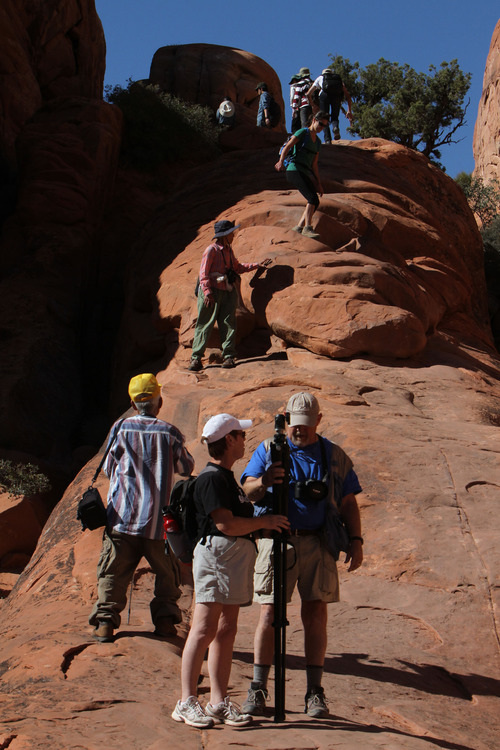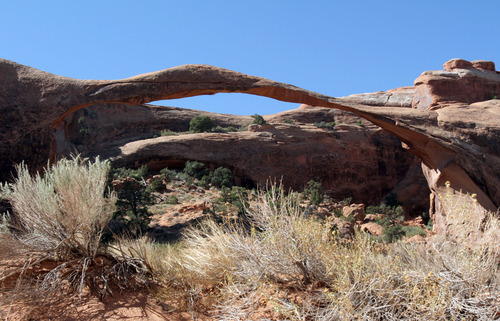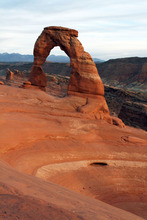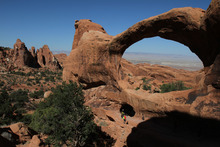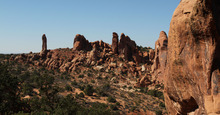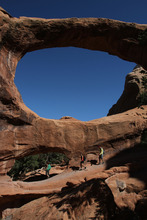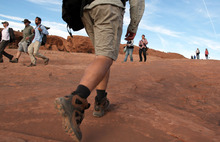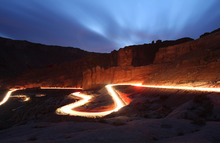This is an archived article that was published on sltrib.com in 2012, and information in the article may be outdated. It is provided only for personal research purposes and may not be reprinted.
Third in an occasional series examining issues facing Utah's national parks.
Moab • There is no major shopping mall complex in this recreation-destination-laden Grand County town, but Marian DeLay doesn't have to drive too far to experience what it feels like trying to park at one.
"I probably circled the parking loop at the Devils Garden Trailhead five times," said DeLay, executive director of the Moab Area Travel Council, about a recent visit to Arches National Park. "I was there to go for a hike, but I darn near had to take a hike to get to the trailhead because of where I ended up having to park."
National Park Service officials are aware of the lack of parking in Arches. They are exploring options to improve a transportation infrastructure that was designed 50 years ago for an annual visitation of 75,000, but now sees more than 1 million people passing through the gate each year.
The issue quickly became apparent to Kate Cannon when she took over as superintendent for Arches in spring 2006.
"All the cars and tailpipe emissions add to air pollution and fade those famous views that really make this place so wonderful," Cannon said. "We want to do our part to keep the park clear and beautiful, reduce cars and give people the experience they hope for when they visit Arches."
The goal of the "Alternative Transportation System and Congestion Management Study" is to reduce traffic congestion, air and noise pollution, greenhouse gas emissions and the impacts of transportation on the parks' valuable resources. There is a target of diverting 25 percent of intended traffic in the park. That does not mean reducing the number of visitors, only the number of vehicles in Arches.
"We don't feel that we have an issue with too many people, just with too many cars," Cannon said.
Coming up with the title for the study has proven easier than finding solutions.
The most obvious option appeared to be a shuttle system. It works in other national parks, including two in Utah — Zion and Bryce. Initial cost estimates, however, show that a shuttle — at least one paid for by the National Park Service and limited to park boundaries — would be costly and could be obsolete as visitation to Arches continues to grow. The cost of running the shuttle all 18 miles from the entrance to the Devils Garden parking lot is one of the main issues.
"It has turned out that there is not an easy answer. We were hoping with a reduced shuttle program we could make it more feasible for us to pay, but as it turns out that would not solve the problem; in the long term we would be overtaken by an increase in visitors," Cannon said.
An adequate shuttle system at Arches, at least based on current visitation, would cost about $1.4 million in its first full year and increase with inflation according to the superintendent.
Arches officials are allowed to charge a transportation fee, but are "sensitive" about increasing the cost of visiting the popular Utah park.
Options explored during discussions on ways to reduce traffic in Arches ranged from implementing a reservation system for entry into the park and allowing drive-up visitors to enter when the slots were not full to running a shuttle only to the Windows section of the park to a "congestion management only strategy" that diverts cars away from high-traffic areas through communications with park visitors and local partners.
DeLay would like to see more involvement from businesses that thrive due to the visitors which Arches helps draw to the Moab area and perhaps even involvement from the city itself.
"There have been talks about a plan that would include a shuttle that goes from town into the park and runs all day," DeLay said. "That seems like a perfect plan. Moab really needs some kind of transportation system and if there could be a way to combine the two, it really would make sense."
The challenge of a joint effort between Moab and the national park would be figuring out a way to collect a fare at the park entrance. Parks across the country have different ways of handling fee collection for shuttle riders, and it is not likely something that will halt the possibility of a partnership.
Jeff and Penny Richards of Moab enjoy taking their daughters into Arches whenever time allows. They like the idea of a shuttle because they know it may make parking a little easier when they visit, but they don't want to see people forced to park at the entrance and herded into time-consuming mass transit.
"For locals like us who have already seen most areas of the park, we have a specific destination in mind and would prefer to go straight there," Jeff Richards said. "I would use the shuttle if there were enough vehicles to get people to and fro in a timely fashion."
The Richardses also support the idea of a shuttle headed to the park from Moab because many of the tourists who visit the park spend multiple days in hotels near Arches. They feel that if leaving the car at the hotel and riding the shuttle somehow saved money that visitors would be more inclined to catch a ride.
Park officials will continue to explore options for reducing the number of cars in Arches, but, like many other National Park Service superintendents across the country Cannon suggests she will wait to see what happens with the presidential election before making any firm decisions.
"Stay tuned. We have got to resolve this somehow," she said. "This is not the product we want. This is not the contribution we want to make for air quality and visitor experience."
Five things not to miss in Arches
Delicate Arch • Seeing this iconic arch, perhaps the most famous in the world, on Utah license plates does not count. You can see Delicate from a distance at the Delicate Arch Viewpoints or get up close and intimate with 3-mile round trip hike to the bowl that holds the arch. The moderately strenuous hike is over slickrock and is exposed to the sun most of the way. Take water and wear good shoes. People with a fear of heights may have a hard time with the last portion of the trail along a cliff.
The Windows Section • Studies show that the Windows Section is the most visited part of the park. The 1-mile round trip hike/walk provides views of North and South Windows and Turret Arch.
Fiery Furnace • Ranger-led hikes in this confusing obstacle course of narrow canyons are popular. Reservations for the hikes are available up to six months in advance from http://www.recreation.gov. The cost is $10 for adults (13 and older) and $5 for children (under 5 not allowed).
Landscape Arch • How long will the skinny 306-foot-long Landscape Arch remain standing? Make the easy 1.6-mile round trip hike from the Devils Garden Trailhead to see it before it's gone. A 60-foot long and 11-foot wide slab of rock fell from under the arch in 1991. Those with a thirst for a little more hiking can continue past Landscape to Double O Arch and the monolith known as Black Angel.
Camping at Devils Garden • Few campgrounds in Utah, or the rest of the country, are as family friendly and scenic at Devils Garden. Reservations for group and individual sites are made on http://www.recreation.gov. The sites are first-come, first-serve in the winter months.
Brett Prettyman


